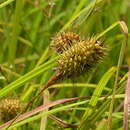Comprehensive Description
provided by North American Flora
Carex squarrosa L. Sp. PI. 973. 1753
Carex squarrosa f. robusta Peck, Ann. Rep. N. Y. State Mus. 48: 198. 1896. (Type from New York.)
Cespitose, the rootstock short, thick, stout, blackish, the clumps medium-sized or large,
the culms 3-9 dm. high, erect, slender, much exceeded by the upper leaves, aphyllopodic, sharply triangular with flat or concave sides, roughened on the angles above, blackish or brownish at base, the dried-up leaves of the previous year few; sterile shoots elongate, leafy; leaves with well-developed blades 4-9 to a fertile culm, regularly disposed and not clustered at base, the blades flat with slightly revolute margins, usually 2-3 dm. long, 2-6 mm. wide, thin but firm, light-green, very rough on the margins and toward the apex, the sheaths close or but little loose, brownish-hyaline ventrally, conspicuously prolonged upward beyond base of blade, the ligule much longer than wide; spike solitary or spikes occasionally 2-4 and contiguous, the lateral on short, slender, ascending peduncles, the lower third or half of the terminal one staminate, the staminate scales loose, lanceolate or ovate-lanceolate, cuspidate to acute, light-reddish-brown with lighter or greenish 3-nerved center and hyaline margins; pistillate portion and lateral spikes oval or oblong-oval, 1-3 cm. long, 15-22 mm. wide, rounded at the top, very densely flowered, the numerous perigynia in many rows, squarrose, the beaks radiating in all directions; bracts much reduced, long-attenuate, not sheathing, generally not shorter than the inflorescence ; pistillate scales oblong-lanceolate, acute to shortawned, at maturity light-reddish-brown with conspicuous 3-nerved center, narrower and much shorter than the perigynia ; perigynia with broadly obovoid-cuneate body, 4—5 mm. long, about 3 mm. wide, inflated and suborbicular in cross-section, glabrous, membranaceous, greenishstraw-colored or brownish at maturity, strongly several-ribbed above, round-tapering and sessile at base, truncate-depressed above and abruptly slenderly conic-beaked, the beak 2.5-3.5 mm. long, smooth or slightly serrulate, slightly tawny-tipped, the slender teeth erect, stiff, 0.25 mm. long; achenes linear-oval, 3 mm. long, 1.5 mm. wide, triangular with flattish sides and blunt angles, loosely enveloped, blackish with prominent superficial cells, minutely granular, short-stipitate, tapering at base, tapering into and continuous with the slender persistent style very strongly sinuous or abruptly bent below; stigmas 3, slender, light-reddish brown, short.
Type locality: "Habitat in Canada, Kalm."
Distribution: Swampy or wet woods, acid soils, western Quebec and western New England to Wisconsin and Nebraska, and southward to North Carolina and Arkansas. (Specimens examined from western Quebec, southwestern Ontario, Connecticut, New York, New Jersey, Pennsylvania, Delaware, Ohio, Michigan, Indiana, Illinois, Wisconsin, Maryland, District of Columbia, Virginia, North Carolina, Kentucky, Tennessee, Iowa, Missouri, Nebraska, Arkansas.)
- bibliographic citation
- Kenneth Kent Mackenzie. 1935. (POALES); CYPERACEAE; CARICEAE. North American flora. vol 18(7). New York Botanical Garden, New York, NY

